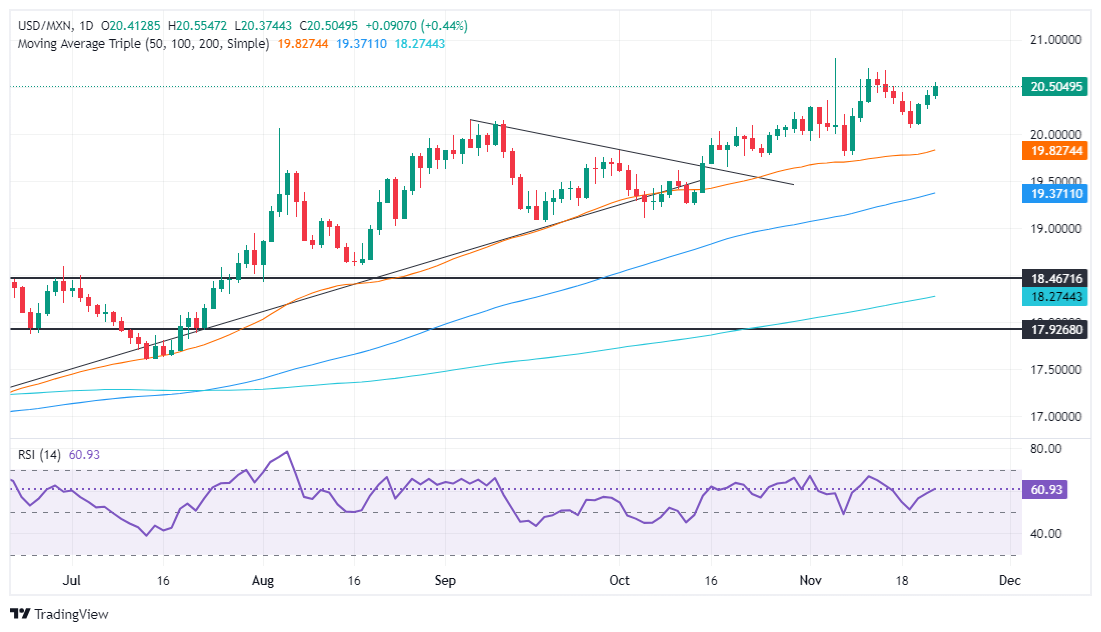- Mexican Peso ignores upbeat growth data as inflation dip hints at lower interest rates.
- INEGI reports Q3 GDP growth exceeding expectations and a drop in mid-month November inflation, suggesting room for Banxico to ease policy further.
- US economic data, including better-than-expected S&P Global Flash PMIs and UoM Consumer Sentiment, bolstered the US Dollar.
The Mexican Peso retreats for the third straight day versus the US Dollar, although economic data suggests the country’s economy grew in the third quarter while inflation edged lower. However, upbear US data coupled with risk aversion boosted the USD/MXN higher, trading at 20.45, gaining 0.27%.
In Mexico, the Instituto Nacional de Estadistica Geografía e Informatica (INEGI) revealed the final Reading of the Gross Domestic Product (GDP) for Q3 2024, which exceeded estimates in quarterly and yearly numbers. At the same time, November’s Mid-month inflation was below the previous month’s reading and estimates in headline and core, hinting that the Bank of Mexico (Banxico) could continue to ease policy.
The US economic docket revealed that business activity improved, according to S&P Global Flash PMIs for November. Meanwhile, the University of Michigan (UoM) Consumer Sentiment in November improved compared to its previous reading, while inflation expectations for one year dipped.
This and geopolitical jitters underpinned the USD/MXN toward new weekly highs of 20.55. It is worth noting that Mexico’s Chamber of Deputies approved the dissolution of autonomous bodies, which, according to experts, puts Mexico at risk of being taken out of the USMCA free trade agreement.
Bank of Mexico Governor Victoria Rodriguez Ceja said they’re ready to slash interest rates if inflation continues downward. This would exert downward pressure on the Peso, which has depreciated after former US President Donald Trump’s victory boosted the Greenback. Since then, the Federal Reserve (Fed) has adopted a cautious stance on easing policy, as some of Trump’s proposals exert upward inflation pressure.
Money market players had grown more cautious about the Fed cutting rates. The CME FedWatch Tool suggests that investors see a 56% chance of a 25-basis-point rate cut at the December meeting, down from 59% a day ago.
Daily digest market movers: Mexican Peso falls as bets for Banxico rate cuts increased
- Mexico’s mid-month inflation rate eased in early November, increasing bets that Banxico would ease policy.
- Headline inflation hit 4.56% YoY, down from 4.69% in the previous month, after rising in the previous pair of two-week periods. Economists expected inflation to remain unchanged, according to a Reuters poll.
- Core inflation, usually seen as a better gauge of price trends because it strips out volatile energy and food prices, came in below the forecast of 3.72% at 3.58% YoY.
- Mexico's GDP for the third quarter of 2024 expanded by 1.1% in the third quarter compared to Q2 and is almost in line with the 1.0% increase expected by economists.
- In annual terms, the economy expanded by 1.6% compared to a year earlier, slower than the previous reading and slightly above the 1.5% foreseen by economists.
- US S&P Global Services and Composite PMIs for November expanded by 57.0 and 55.3, exceeding the previous month's reading; the Manufacturing PMI improved from 48.5 to 48.8, as expected.
- The UoM Consumer Sentiment in November improved from 70.5 to 71.8 but missed the mark. Inflation expectations for one year dipped from 2.7% to 2.6% as projected.
- Data from the Chicago Board of Trade, via the December fed funds rate futures contract, shows investors estimate 22 bps of Fed easing by the end of 2024.
- Last week, Moody’s changed Mexico’s credit outlook to negative, mentioning constitutional reforms that could negatively impact Mexico’s economic and fiscal strength.
USD/MXN technical outlook: Mexican Peso slumps as USD/MXN climbs past 20.45
The USD/MXN remains upwardly biased despite retreating below the psychological 20.50 figure. A breach of the latter will expose the current day high at 20.55, followed by the November 12 peak at 20.69. Once cleared, the next resistance would be the year-to-date (YTD) high of 20.80.
If sellers push the exchange rate below 20.00, they could test the 50-day Simple Moving Average (SMA) and the November 7 low around 19.75/78, followed by the 19.50 mark.
Indicators such as the Relative Strength Index (RSI) remain bullish in the short and medium term, hinting that further upside is available.

Mexican Peso FAQs
The Mexican Peso (MXN) is the most traded currency among its Latin American peers. Its value is broadly determined by the performance of the Mexican economy, the country’s central bank’s policy, the amount of foreign investment in the country and even the levels of remittances sent by Mexicans who live abroad, particularly in the United States. Geopolitical trends can also move MXN: for example, the process of nearshoring – or the decision by some firms to relocate manufacturing capacity and supply chains closer to their home countries – is also seen as a catalyst for the Mexican currency as the country is considered a key manufacturing hub in the American continent. Another catalyst for MXN is Oil prices as Mexico is a key exporter of the commodity.
The main objective of Mexico’s central bank, also known as Banxico, is to maintain inflation at low and stable levels (at or close to its target of 3%, the midpoint in a tolerance band of between 2% and 4%). To this end, the bank sets an appropriate level of interest rates. When inflation is too high, Banxico will attempt to tame it by raising interest rates, making it more expensive for households and businesses to borrow money, thus cooling demand and the overall economy. Higher interest rates are generally positive for the Mexican Peso (MXN) as they lead to higher yields, making the country a more attractive place for investors. On the contrary, lower interest rates tend to weaken MXN.
Macroeconomic data releases are key to assess the state of the economy and can have an impact on the Mexican Peso (MXN) valuation. A strong Mexican economy, based on high economic growth, low unemployment and high confidence is good for MXN. Not only does it attract more foreign investment but it may encourage the Bank of Mexico (Banxico) to increase interest rates, particularly if this strength comes together with elevated inflation. However, if economic data is weak, MXN is likely to depreciate.
As an emerging-market currency, the Mexican Peso (MXN) tends to strive during risk-on periods, or when investors perceive that broader market risks are low and thus are eager to engage with investments that carry a higher risk. Conversely, MXN tends to weaken at times of market turbulence or economic uncertainty as investors tend to sell higher-risk assets and flee to the more-stable safe havens.





